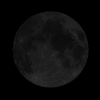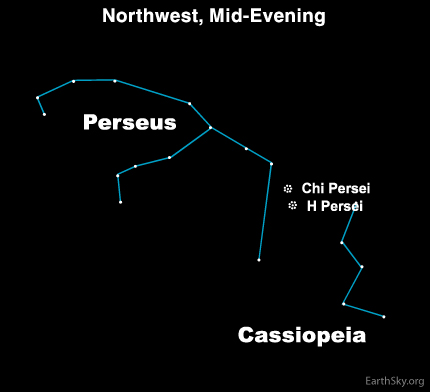Courtesy of EarthSky
A Clear Voice for Science
Visit EarthSky at
www.EarthSky.org [1]
 [2]
[2] [3]To find the gorgeous Double Cluster in the constellation Perseus, face north to northwest as darkness falls this evening. Here you can find the Double Cluster in the constellation Perseus. These are two open star clusters, known as “H” and “Chi” Persei (also called NGC 884 and 869).
[3]To find the gorgeous Double Cluster in the constellation Perseus, face north to northwest as darkness falls this evening. Here you can find the Double Cluster in the constellation Perseus. These are two open star clusters, known as “H” and “Chi” Persei (also called NGC 884 and 869).
How to find them? First, you need a dark sky. Second, you may need binoculars, as the Double Cluster is only faintly visible to the unaided eye – even on an inky black night. Look for the famous constellation Cassiopeia in the northwest, forming a backwards “3,” or perhaps an “E,” or the letter “M” or “W” turned on its side. Just above Cassiopeia, assuming your sky is dark enough, you will see a faint fuzzy patch. This is the Double Cluster, which blooms into a sparkling array of stars through binoculars or a small backyard telescope.
These two open star clusters reside an estimated 7,400 light years away. Each contains 300 to 400 stars. These stars are thought to be approximately three million years old … babies in star time! The stellar gas and the myriad stars that compose the flat disk of our Milky Way galaxy passes right through Cassiopeia and Perseus – and in front and behind the Double Cluster. If your sky is dark enough, you will see the hazy pathway of the winter Milky Way crossing this part of the sky.
The Double Cluster was charted by skywatchers as early 150 B.C. Hipparchus saw it, and Ptolemy named it as one of seven “nebulosities” in the Almagest, an ancient astronomy text used for over a millennium. The Double Cluster in Perseus ranks as a favorite among stargazers, a bejeweled place in the heavens to zoom in on with binoculars.
Tough binocular challenge after sunset:
With the moon setting an hour or more after the sun in the northern and western parts of North America, you might – if you are lucky – catch the thinnest of lunar crescents over your west-southwest horizon as dusk deepens into darkness. However, you will need an unobstructed horizon in the direction of sunset and crystal-clear skies to see this evening’s extremely young moon. The moon is exactly 24 hours old (or past new moon [4]) at 7:03 p.m. Pacific Time or 8:03 p.m. Mountain Time. Good luck!
Looking for a sky almanac? EarthSky recommends [5]
![]() [6]Written by Deborah Byrd [7]
[6]Written by Deborah Byrd [7]
Astronomy Picture of the Day from NASA/JPL [8]
EarthSky: Space [9]
CHANDRA Photo Album [10]
U.S. Naval Observator Astronomical Information cente [11]r
Universe Today [12]
StarDate Online [13]
Sky and Telescope [14]
National Geographic [15]
Space Com [16]
Simostronomy Blog [17]
Amazing Space [18]
The York County Astronomical Society [19]
Scope City [20]